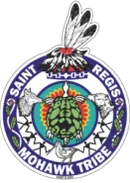AKWESASNE — On Ohiarihkó:wa/July 31, 2019; the Saint Regis Mohawk Tribe’s (SRMT) Environment Division held a public presentation of the Emerald Ash Borer (EAB) survey results that was conducted in partnership with the U.S. Forest Service and the United States Department of Agriculture. The purpose of the survey was to determine the extent of EAB’s infestation for the development of plans that will help mitigate their impact on the community of Akwesasne.
The survey found that the Emerald Ash Borer is spreading from the northwest to the southeast at an increasing rate, with the greatest densities now located in the areas of Raquette Point and Rooseveltown. The infestation is projected to continue increasing over the next few years and will affect 90 percent of all ash trees in Akwesasne. As the Emerald Ash Borer spreads, public hazards will be posed when limbs become brittle and break off before the tree eventually falls.
“The survey helped identify areas with the greatest infestations that were not previously located through our annual trapping efforts,” shared Environment Division Assistant Director Les Benedict. Benedict added, “The survey’s findings discovered that the infestation is still in the early stages, but is progressing farther east. This information has been helpful in developing mitigation plans that will assist in reducing the threat that the Emerald Ash Borer poses.”
To help reduce the spread of the Emerald Ash Borer and the risks associated with dead trees, one measure being implemented by the Tribe’s Environment Division is for the safe removal and replacement of ash trees located alongside Akwesasne’s roadways, particularly along Route 37. The highway spans nearly 7 ½ miles from the western portion of the community to the east and includes an estimated 200 ash trees that were planted when the road was rebuilt in the 1980’s.
In advance of the Emerald Ash Borer’s spread eastward in Akwesasne, the Environment Division is conducting a call out for property owners along Route 37 who are willing to have an ash tree safely removed and replaced with another tree type. Replacement trees may include maple, oak, hop hornbeam, blue beech, sassafras, hickory, horse chestnut, patriot elm, flowering crab, hawthorn, catalpa and osage orange, and more, depending on matching soil conditions.
The responsibility of maintaining and caring for the replacement trees, or any remaining ash trees, rests with the landowner. For one time however, the Environment Division is providing property owners with the chance to help improve street tree health by having an ash tree removed and replaced at no cost. Property owners have until Seskehkó:wa/September 30th to express their desire to have an ash tree safely removed and replaced. Any requests received after September 30th will be at the landowner’s expense.
“The management of our community’s resources and the safety of the public are important to us,” noted Environment Division Director Tony David. He emphasized,” We encourage property owners with ash trees along Route 37 to please contact Environment before September 30th to take advantage of this opportunity to have them removed and replaced before they become infested and pose a hazard.”
Community members should take note that there are no plans to treat ash trees with pesticides or to have them removed from an individual’s property once the infestation and damage begins.
For further information about the ash tree removal project, please call the Tribe’s Environment Division at (518) 358-5937 or visit their office during normal business hours at 449 Frogtown Road in Akwesasne, New York.
#####
The Saint Regis Mohawk Tribal Council is the duly elected and federally recognized government of the Saint Regis Mohawk People

